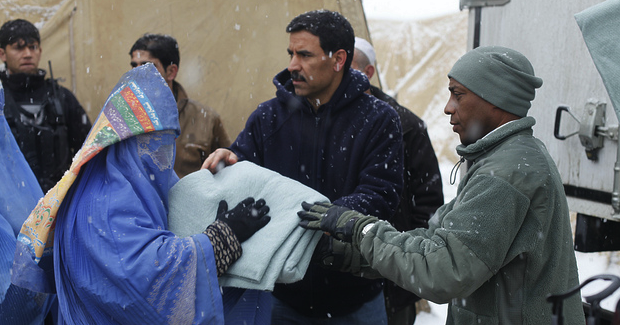World Humanitarian Day: Some Things to Consider

As we celebrate World Humanitarian Day on 19 August let us reflect that while international respect for humanitarian principles have regressed in recent years, the impetus and momentum created by the UN’s World Humanitarian Summit offers an opportunity for progress. Let us grasp this opportunity before it is too late.
The world is experiencing a series of compounded, prolonged and increasingly conflict-based humanitarian crises. In 2015, over 125 million people required daily emergency food, water and shelter for survival. A record, 65.3 million people were displaced by conflict and persecution; a number greater than the combined populations of Australia, New Zealand and Canada. The year also saw the UN Office for the Coordination of Humanitarian Affairs (UNOCHA) respond to five level-three (the most severe large-scale) natural disaster emergencies following the earthquake in Nepal, Cyclone Pam in Vanuatu and severe El Nino impacts across the globe.
Human suffering for the world’s poorest and most vulnerable has reached tremendous levels and the international humanitarian system designed to help has been stretched to its limits.
UN efforts and political will
It is therefore no surprise that recognition and response to such concerns has been high on the international agenda for 2016. Earlier this year, UN Secretary-General Ban Ki-Moon initiated the first ever World Humanitarian Summit (WHS). Calling on all stakeholders—heads of state, private sector and civil society—to come together and recommit to humanity. The summit engaged over 9,000 participants from 173 countries. It encouraged vigorous debate and led to important new international commitments; most notably, the UN secretary-general’s Agenda for Humanity laid out a framework for the future based on five core responsibilities.
Recognising the changing landscape of humanitarian action, the first core responsibility, focuses on increasing political diplomacy, collaboration and the strengthening of UN mediation efforts to prevent conflicts from arising in the first place and, regardless where they do occur, to encourage peaceful political solutions to resolve them.
International responsibilities
The second responsibility is concerned with upholding the international laws and norms that safeguard humanity. Blatant disrespect for the laws of war have led to despicable indiscriminate attacks on civilians and those attempting to deliver humanitarian aid. Medecins Sans Frontieres had 75 of its hospitals bombed last year, while UNICEF reported that, on average, four schools or hospitals are attacked or occupied by armed groups every day. At the summit, UN Deputy Secretary-General Jan Eliasson noted “We have seen a decay, a lack of respect for international law which is causing enormous damage in the world.”
Following on from the UN Sustainable Development Goals, the third core responsibility is ambitiously titled Leave No One Behind. This idea is centred on addressing both the immediate short- and long-term needs of people caught up in humanitarian crises, especially civilians who have been displaced by armed conflict. Syria is a prime example of the need for this responsibility. The country has slipped backwards on all indicators of the Millennium Development Goals over the period 2000 to 2015. With around four million Syrian children now forced out of school, the launch of the Education Cannot Wait fund is another welcome addition. It aims to provide quality education to all children in emergencies and protracted humanitarian crises by 2030.
The importance of commitment
The fourth responsibility shifts focus from merely fulfilling basic needs to ending need itself by reducing vulnerability risks. With 43 per cent of the world’s people already living in fragile environments, commitments here looked at reinforcing domestic systems and taking preemptive action to avoid crises rather than awaiting them before responding. The summit also recognised that humanitarian assistance alone was not a sustainable solution, and instead collaboration with peace-building and development efforts was needed. This led to a number of unique arrangements including the Global Preparedness Partnership which was forged between the Vulnerable 20 Group, the UN and the World Bank as well as the International Red Cross’s One Billion Coalition for Resilience, which aim to helps countries prepare for and survive future disasters.
The final commitment is also probably the most important one. In order to achieve the five core responsibilities, there needs to be adequate, predictable and sustainable financing available. New and unexpected challenges have exhausted cash and material resource reserves and significantly widened the funding gap. In response, the largest ever appeal for financial aid, US$20 billion has been made.
However, in addition to expanding funding streams, emphasis has been put on more efficient, more innovative and more locally based activities. The Grand Bargain agreement, for example, will commit to channelling, as directly as possible, 25 per cent of humanitarian financing to national and local responders by 2020. New partnerships and platforms also complement existing funds such as the UNOCHA’s Central Emergency Response Fund, which allocates approximately $400 million to provide for rapid life-saving assistance at the outbreak of a declared humanitarian crisis.
The World Humanitarian Summit was a once-in-a-lifetime opportunity to get it right and to wake up and take responsibility for the massive level of human suffering currently occurring around the world. As we celebrate World Humanitarian Day, let us reflect that while international respect for humanitarian principles have regressed in recent years, the impetus and momentum created by the summit offers an opportunity for progress. Let us grasp this opportunity before it is too late.
Matthew Kronborg is the executive director of the United Nations Association of Australia (UNAA).
This article is published under a Creative Commons Licence and can be republished with attribution.





